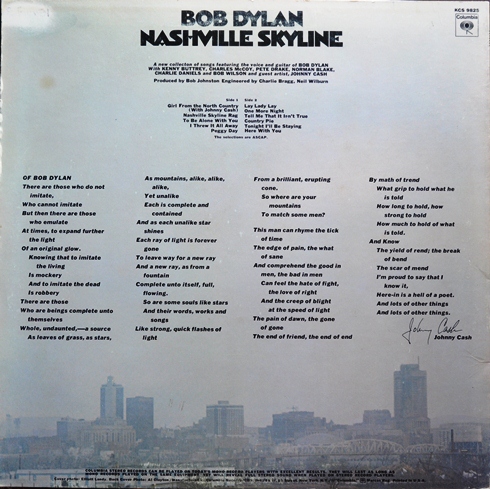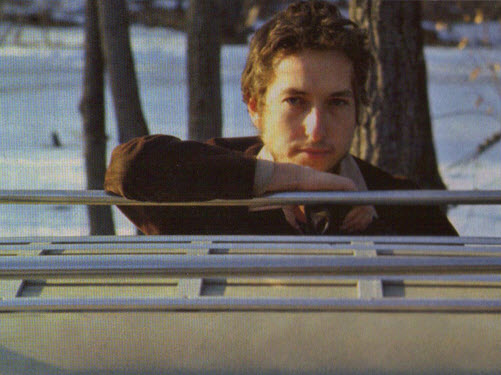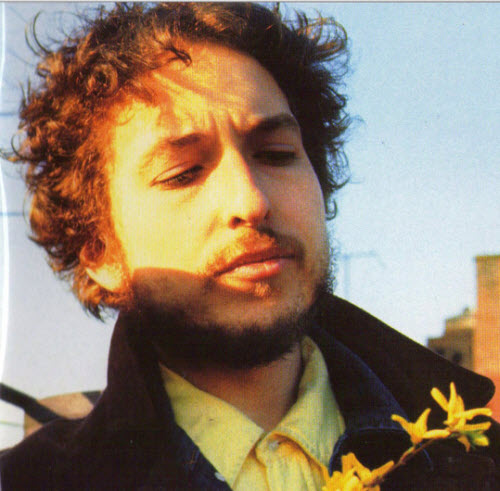Well, Jann, I’ll tell you something. There’s not too much of a change in my singing style, but I’ll tell you something which is true… I stopped smoking. When I stopped smoking my voice changed… So drastically, I couldn’t believe it myself. That’s true. I tell you, you stop smoking those cigarettes (laughter)… and you’ll be able to sing like Caruso.
~Bob Dylan (to Jann Wenner Nov 1969)Anyway, on Nashville Skyline you had to read between the lines. I was trying to grasp something that would lead me on to where I thought I should be, and it didn’t go nowhere – it just went down, down, down.
~Bob Dylan (to Jonathan Cott, Sept 1978)
The first recording session for “Nashville Skyline” was held on February 12, 1969 – but no recordings sheets are available from this session. The second session took place the day after – February 13, 1969. Dylan landed 3 master versions this evening.
Some background from wikipedia:
Nashville Skyline is the ninth studio album by American singer-songwriter Bob Dylan, released in April 1969 by Columbia Records.
Building on the rustic style he experimented with on John Wesley Harding, Nashville Skyline displayed a complete immersion into country music. Along with the more basic lyrical themes, simple songwriting structures, and charming domestic feel, it introduced audiences to a radically new singing voice from Dylan—a soft, affected country croon.
The result received a generally positive reaction from critics, and was a commercial success. Reaching number 3 in the US, the album also scored Dylan his fourth UK number 1 album.
In February 1969, Dylan returned to Nashville to begin work on Nashville Skyline. It had been over a year since his last album, John Wesley Harding, was released, and it had been fifteen months since he produced that album, the last time he was in a recording studio. Many of the Nashville area studio musicians appearing on this album later became the core of Area Code 615 and Barefoot Jerry.
Dylan held sessions at Columbia’s Studio A, scheduling the first on February 12, but there is no record of any work from that first session. A second session held the following day produced master takes of “To Be Alone With You”, “I Threw It All Away”, and “One More Night.” Dylan also made several attempts at “Lay Lady Lay”; as with “I Threw It All Away”, “Lay Lady Lay” was written in 1968, one of the few songs written by Dylan that year.
In the end, Nashville Skyline is a lovely album but not a heavyweight contender, though its effects were major ones. Country music was despised, hick music when Dylan took it up. People were divided into the hip and the non-hip. The counterculture was in full swing and riddled with its own self-importance and snobbery. Nashville Skyline was a hard pill to swallow: but it did ’em good.
~Michael Gray (The Bob Dylan Encyclopedia)
Columbia Studio A
Nashville, Tennessee
February 13, 1969 – 6-9 pm and 9-12 midnight.
Produced by Bob Johnston.
Songs:
- To Be Alone With You
- To Be Alone With You
- To Be Alone With You
- To Be Alone With You
I wrote To Be Alone With You – that’s on Nashville Skyline – I wrote it for Jerry Lee Lewis.
~Bob Dylan (to Jann Wenner Nov 1969)
- To Be Alone With You
- To Be Alone With You
- To Be Alone With You
- To Be Alone With You
- I Threw It All Away
- I Threw It All Away
“I Threw It All Away” is one of two songs on Nashville Skyline that demonstrates enough attention to lyrical detail to suggest that he had lived with it for more than a week.
~Clinton Heylin (Revolution in the air)
- I Threw It All Away
- I Threw It All Away
- Blues
- One More Night
- One More Night
- One More Night
- One More Night
- One More Night
- One More Night
“One More Night” stands as the best of the songs Dylan wrote in haste to fulfill his (nonexistent) contractual obligations in the days/hours leading up to the Nashville Skyline sessions. Unfortunately, the vocal utterly fails to convince us that there is even the slightest heartache underlying the singer’s claims.
~Clinton Heylin (Revolution In The Air)
- Lay Lady Lay
- Lay Lady Lay
- Lay Lady Lay
- Lay Lady Lay
Personnel:
- Bob Dylan (vocal, guitar & harmonica)
- Bob Wilson (piano)
- Charlie Daniels (guitar)
- Charlie McCoy (bass)
- Norman Blake (guitar)
- Kelton D. Herston (probably guitar)
- Kenneth Buttrey (drums).
tracks 9–12
- Wayne Moss (guitar)
- Peter Drake (steel guitar)
Related articles @ JV:
References:
- Bob Dylan: The Recording Sessions – Part One – by Michael Krogsgaard
- Still On The Road – Olof Björner
-Egil





Did I not just read that Charlie Daniels was doing an album of only Dylan songs?
I read that too..
…and me too.
http://theboot.com/charlie-daniels-bob-dylan-new-album/
It is interesting that in CHRONICLES, Bob Dylan heaped a lot of praise on Charlie. This is from rightwingbob.com….
http://www.rightwingbob.com/weblog/archives/207
……Charlie of-course has some Dylan-related history. He played on Nashville Skyline, New Morning and the Self Portrait sessions, before he had made a name for himself in his own right. And, come to discover, one of the items in his book is his personal reaction to reading Howard Sounes’ mean-spirited Bob Dylan bio, Down the Highway. Sounes had interviewed Daniels during the writing of the book. As Charlie tells it in these extracts:
By the conversation I had with him, I assumed that it would be an informative, upbeat book celebrating the life and music of one of the greatest musical poets the world has ever known.
Wrong.
…
He painted a picture of a vindictive, hard-nosed individual who took advantage of situations and was unfaithful to friends. He seemed to take delight in belittling Dylan’s numerous and incredible accomplishments and emphasizing his problems and failures.
…
He painted a totally different picture from the one I have always had of Bob Dylan after spending admittedly a limited amount of time with him. But I just can’t believe that I’m that bad a judge of character.
Neither can I.
The Bob Dylan I remember was fun to work with and fun to be around. With a sense of humor and friendly and courteous manner toward the people with whom he was working, he had a way of making you feel free to do your own thing when you were in the studio with him.
…
I remember him as the family man who brought his wife, Sara, and his young son, Jesse, to Nashville when he recorded Nashville Skyline. I remember him as the giant who gave a bottom-of-the-totem-pole guitar player a chance to be a part of musical history. There’s only one Bob Dylan, and I’m thankful to have had the opportunity to walk in his shadow for a season.
Daniels also played on the much talked-about (and bootlegged) studio session when Dylan and George Harrison goofed around on a variety of tunes. Charlie played bass, with Russ Kunkel on drums. Paul McCartney had just split from the Fab Four, and in his book Charlie recalls Harrison asking him (laughingly), “Do you want to be a Beatle?”
So much for Charlie Daniels’ recollections—all warm ones—of working with Dylan. Come the fall of 2004, we got to hear Dylan’s recollection of working with Charlie, in his still-to-be-fully-appreciated book, Chronicles. Writing about the recording of New Morning, and his colorful producer Bob Johnston, Dylan says:
I was wondering who he was going to bring to the sessions this time and was hoping he’d bring Charlie Daniels. He’d brought Charlie before, but he’d failed to bring him a few times, too. I felt I had a lot in common with Charlie. The kind of phrases he’d use, his sense of humor, his relationship to work, his tolerance for certain things. Felt like we had dreamed the same dream with all the same distant places. A lot of his recollections seemed to coincide with mine. Charlie would fiddle with stuff and make sense of it. … When Charlie was around, something good would usually come out of the sessions. … Years earlier Charlie had a band in his hometown called The Jaguars who had made a few surf rockabilly records, and although I hadn’t made any records in my hometown, I had a band too, about the same time. I felt our early histories were somewhat similar. Charlie eventually struck it big. After hearing the Allman Brothers and the side-winding Lynyrd Skynyrd, he’d find his groove and prove himself with his own brand of dynamics, coming up with a new form of hillbilly boogie that was pure genius. Atomic fueled—with surrealistic double fiddle playing and great tunes like Devil Went Down to Georgia …
It doesn’t get much warmer than that. Admittedly, Chronicles is a memoir disinguished by its kindness to the characters Dylan remembers from his strange and long trip. He’s clearly thinking like Johnny Mercer a lot of the time; accentuating the positive. Still, I’m hard-pressed to come up with another musical contemporary who gets quite the treatment Charlie Daniels does in that passage just quoted. Since Chronicles came out about a year after Ain’t No Rag, one might speculate that it was a little quid pro quo, so to speak. But that would be a stretch, I think. Dylan had been working on Chronicles since 2001 or even earlier, and what are really the chances he’d read Ain’t No Rag and made last minute changes to his own book as payback? No—as already mentioned, his way of remembering Daniels fits the overall tone of his book, and it rings true, just as the rest of Chronicles rings true, despite some peoples’ preference for dismissing it as “re-invention.”
Whaaoo.. Walker!
Thanks for sharing this great stuff about Charlie Daniels <-> Bob Dylan.
Wonderful.
-Egil
I met Charlie Daniels at B B King’s in NYC in the fall of 2007, and could not resist asking him about working with B Dylan. He looked at me with a glint in his eye and said that it was really special.
Thanks for a nice comment Walker!
I’m sure it must have been really special… lucky man..
-Egil